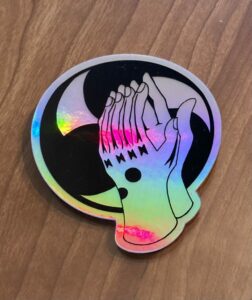
Hajichi are a very unusual but significant form of graphic language, both highly endangered and a great illustration of the intimate relationship between graphic systems and their culture of origin: Okinawan women’s hand-tattoos.
According to a blog post by Alexis Miyake about the fascinating tradition of tattooing practiced by women of the islands, “When Okinawa was under the rule of the Ryukyu monarchy, Uchinanchu [Okinawan] women wore indigo tattoos known as hajichi on the backs of their hands. These tattoos functioned as symbols of the transition from adolescence to womanhood and also as indicators of social status.
“In tattoos of the lower classes, commonly used icons included arrowheads, circles, and squares. According to historians, the arrowhead represented daughters never coming back to their families once they married into another house, just as arrowheads never return to their origin. The circle represented winding thread and the square represented a sewing box; these two items were important because back then, a girl could not marry if she didn’t know how to sew.
“Uchinanchu women who came from higher-class families had more intricate, ornate tattoos that sometimes went all the way up their arms. Little is known about these upper-class tattoos, as documentation in English is scant. No matter their status, all Uchinanchu women were said to value their hajichi over their wealth, their husbands, and life itself, as the tattoos were thought to ward off evil, ensure safety, and bring happiness.”
These tattoos are a perfect example of forms of graphic communication that fall outside the Western definition of writing as an abstract set of phonetic symbols, yet are clearly rich, complex and extraordinarily important, and make use of available indigenous materials.
Unfortunately, they are also an example of the way in which a new dominating culture fears and tries to eradicate the meaning-symbols of cultures they want to control or suppress.
“When Japan took control of the Ryukyu Kingdom in the late 19th century, the practice of tattooing was banned. The reasons were multifold. Tattoos were looked down upon by Japanese society; at the same time, Japanese authorities wished to strengthen their own influence by reducing the influence held by village head priestesses. According to ancient Ryukyuan beliefs, women ruled the spiritual domain and were believed to possess innate spiritual powers; they were called onarigami while men were called umiki—the rulers of the secular domain. Hajichi functioned as signifiers and transmitters of female power.”
The stigma was so consistently reinforced that “Eventually, the hajichi became a symbol of shame; in some photos of Uchinanchu women, their hands are held palms up or tucked into their sleeves in order to hide the hajichi on the backs of their hands.”
According to Alexis Miyake, there is now the beginning of a renaissance in the use of hajichi. In 2015, she wrote “Today, attitudes have changed. The contemporary generation in Okinawa is becoming more aware of ancient indigenous traditions, and a resurgence in the lost art of Uchinanchu tattoos can be seen among some younger Okinawan women.”
In 2020, an exhibition featuring pictures taken of hajichi was organized in Japan, and advocacy stickers are now in circulation to support the use of and respect for hajichi.
If anyone has photos of hajichi and wouldn’t mind sending them, we’d love to see them and post them with this profile.
Latitude: 26° 12′ 44.6436” N
Longitude: 127° 40′ 51.3552” E
4.8.33